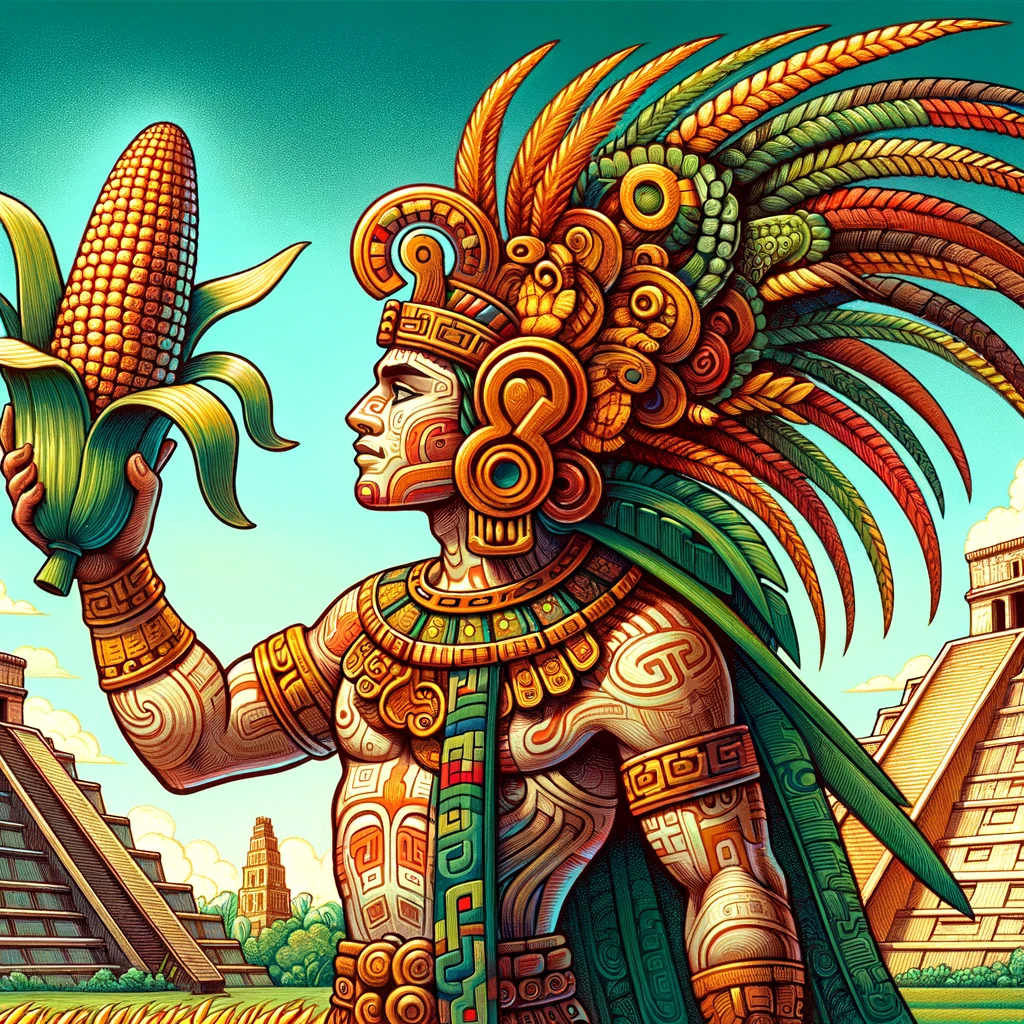
In the rich pantheon of Aztec mythology, Centeotl holds a significant place as the deity of maize and agriculture.
Origins and Mythology
Centeotl, whose name literally means "Maize Cob," is a deity whose roots are deeply intertwined with the agricultural practices and lifeways of the Aztec people. The Aztecs, a Mesoamerican culture that flourished in central Mexico from the 14th to the 16th centuries, revered maize as a staple of their diet and a cornerstone of their economy.
The mythology surrounding Centeotl often portrays him as a young and benevolent god, closely associated with the earth and the sustenance it provides. He is sometimes depicted as the son of Tlazolteotl, the goddess of fertility and childbirth, and as the husband of Xochiquetzal, the goddess of beauty and love, which further emphasizes his role in fertility and agricultural bounty.
Depictions and Symbolism
In Aztec art and iconography, Centeotl is frequently depicted with features that symbolize his connection to maize and the earth. He often appears with a youthful face, sometimes adorned with maize leaves or kernels. His body and face may be painted yellow, the color of ripe maize, symbolizing the ripeness and fertility of the crops.
Centeotl's imagery is commonly found in various forms of Aztec art, including sculptures, codices, and frescoes. These depictions not only served a religious purpose but also functioned as a testament to the central role of agriculture in Aztec society.
Worship and Rituals
The worship of Centeotl was marked by various rituals and ceremonies, especially during the maize planting and harvesting seasons. One of the most significant festivals in his honor was the Xilonen ceremony, which celebrated the first maize harvest. During this festival, young girls would perform dances and offer prayers to Centeotl, asking for his blessings for a bountiful harvest.
Priests and devotees would offer maize and blood sacrifices to Centeotl, seeking his favor for fruitful crops. These rituals underscored the reciprocal relationship between the Aztecs and their deities, where human efforts in ritual were believed to ensure divine favor and intervention.
Cultural Significance
Centeotl's importance extends beyond the realms of agriculture and religion; he represents the interconnectedness of Aztec society with their environment. The deity served as a reminder of the dependence of humans on the natural world and the need to maintain a harmonious balance with it.
The reverence for Centeotl also highlights the Aztecs' sophisticated agricultural techniques, including their use of chinampas (floating gardens), which allowed them to maximize crop production in the swampy conditions of the Valley of Mexico.
Conclusion
Centeotl, the Aztec god of maize, embodies the profound relationship between the Aztec people and their environment. His worship reflects the centrality of maize in Aztec life and underscores the cultural and religious significance of agriculture. As a symbol of fertility and sustenance, Centeotl remains a fascinating figure in the study of Aztec mythology and Mesoamerican civilizations.
Origins and Mythology
Centeotl, whose name literally means "Maize Cob," is a deity whose roots are deeply intertwined with the agricultural practices and lifeways of the Aztec people. The Aztecs, a Mesoamerican culture that flourished in central Mexico from the 14th to the 16th centuries, revered maize as a staple of their diet and a cornerstone of their economy.
The mythology surrounding Centeotl often portrays him as a young and benevolent god, closely associated with the earth and the sustenance it provides. He is sometimes depicted as the son of Tlazolteotl, the goddess of fertility and childbirth, and as the husband of Xochiquetzal, the goddess of beauty and love, which further emphasizes his role in fertility and agricultural bounty.
Depictions and Symbolism
In Aztec art and iconography, Centeotl is frequently depicted with features that symbolize his connection to maize and the earth. He often appears with a youthful face, sometimes adorned with maize leaves or kernels. His body and face may be painted yellow, the color of ripe maize, symbolizing the ripeness and fertility of the crops.
Centeotl's imagery is commonly found in various forms of Aztec art, including sculptures, codices, and frescoes. These depictions not only served a religious purpose but also functioned as a testament to the central role of agriculture in Aztec society.
Worship and Rituals
The worship of Centeotl was marked by various rituals and ceremonies, especially during the maize planting and harvesting seasons. One of the most significant festivals in his honor was the Xilonen ceremony, which celebrated the first maize harvest. During this festival, young girls would perform dances and offer prayers to Centeotl, asking for his blessings for a bountiful harvest.
Priests and devotees would offer maize and blood sacrifices to Centeotl, seeking his favor for fruitful crops. These rituals underscored the reciprocal relationship between the Aztecs and their deities, where human efforts in ritual were believed to ensure divine favor and intervention.
Cultural Significance
Centeotl's importance extends beyond the realms of agriculture and religion; he represents the interconnectedness of Aztec society with their environment. The deity served as a reminder of the dependence of humans on the natural world and the need to maintain a harmonious balance with it.
The reverence for Centeotl also highlights the Aztecs' sophisticated agricultural techniques, including their use of chinampas (floating gardens), which allowed them to maximize crop production in the swampy conditions of the Valley of Mexico.
Conclusion
Centeotl, the Aztec god of maize, embodies the profound relationship between the Aztec people and their environment. His worship reflects the centrality of maize in Aztec life and underscores the cultural and religious significance of agriculture. As a symbol of fertility and sustenance, Centeotl remains a fascinating figure in the study of Aztec mythology and Mesoamerican civilizations.